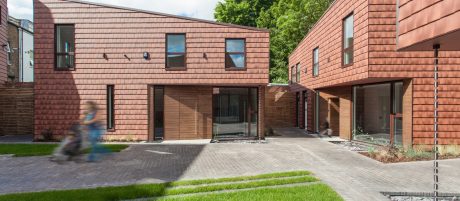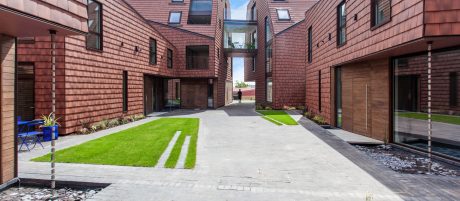The courtyard provides a tranquil shared haven from gritty urban life. It encourages interaction amongst residents, promoting well-being and a deeper idea of community. The sculptural angular forms of the buildings allow sunlight into the courtyard all year, glistening off the shallow reflecting pools and glowing off the warm clay tiles that adorn the roof and walls.
At the heart of the project is the Sociable Space – the shared courtyard. The quality of the outside space and the relationship of this space to the new buildings was paramount to the concept.
The landscape design involved the selection of high impact, low maintenance planting. It leads from the street, provides a street front set-back, the pedestrian route through the fissure in the building and opens out into the communal courtyard garden.
Raised planters, grassed areas, angular beds and brick-edged reflection pools are set within the brick paving to create an informal garden. The designers were very thoughtful with providing every resident a direct connection with nature.
The shared garden is a place to relax, socialize, and play. Each house has its own courtyard which opens onto the central garden. The interchange between public and private space has been planned meticulously - from the most public street-front through to the most private spaces in the homes. Embracing the concept of sociable housing, the line between the private and shared space is delineated by a change in the coursing of the brick pavers – creating separation, without putting up fences. The large picture windows onto the kitchen/dining space are separated from the shared courtyard by a brick edged reflecting pool. This provides a privacy ‘buffer’ for the window, a source of water for wildlife, a playful feature for children, and a reflective surface which projects rippled light into the interior room. It holds rainwater, via rain chains, part of the overall SuDs system.
The brick was chosen as it provided a robust yet familiar material, could be designed in a way to delineate spaces, and form edging to the pools. The blue colour was chosen to compliment the planting, the river slates in the ponds, the interior floor tiles and the striking terracotta tiles which clad the buildings.
During lockdown, this communal garden became the focal point of the development, providing respite, refuge, play and entertainment. The children who live here use it as a racetrack for their bikes, a stage for their theatre productions, and a surface for their chalk-drawn illustrations and games – it is like a big blackboard! As such, it has been an excellent choice for an external area.
Together with the design, landscaping, ‘neighbouryard’, and reflection pools, the development has a clear drive to enhance the well-being and sociability of the residents.






